RBA Governor Phil Lowe did a pretty good job last night explaining how Australia’s housing market was caught short by the surge in immigration in the early-2000s, which created a structural imbalance between dwelling supply and demand and helped force-up house prices and household debt:
“…as is often the case in economics, it [the housing market] largely comes down to supply and demand. On the demand side, population growth in Australia – especially in our largest cities – picked up unexpectedly in the mid 2000s and it is only in the past couple of years that the rate of home building has responded. This imbalance was compounded by insufficient investment in the transport infrastructure needed to support our growing population. Nothing increases the supply of well-located land like good transport links. Underinvestment in this area is one of the factors that has pushed housing prices up. Put simply, the supply side simply did not keep pace with the stronger demand side. The result has been higher prices”.
Not surprisingly, the rising prices have encouraged people to buy residential property as an investment in the hope of ongoing capital gains. With global interest rates so low, many investors have found it attractive to borrow money to invest in appreciating residential property. This has reinforced the upward pressure on prices.
Fair enough observation, which is illustrated by the below charts. First, note the massive ramp-up in net overseas migration (NOM) in the early-2000s:
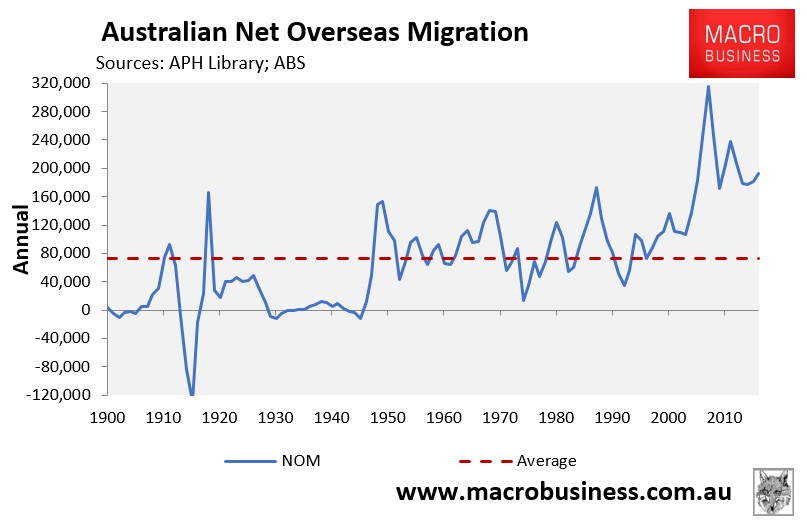
That has driven the huge growth in population, which is projected to continue long into the future on the back of continued strong migrant inflows:
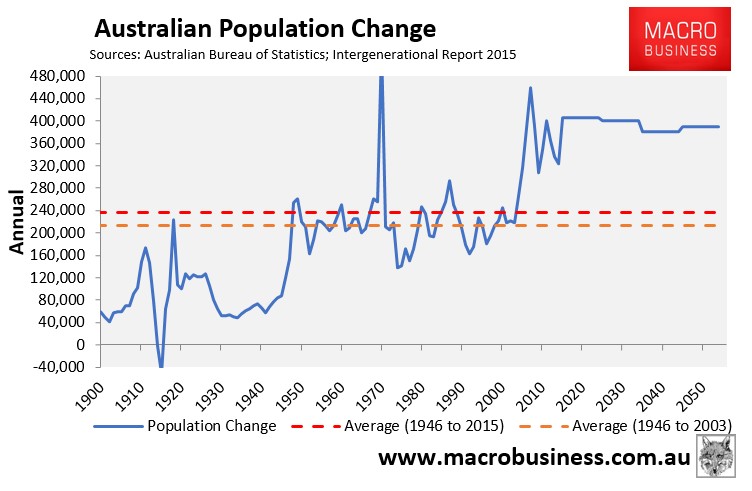
Rather than being “unexpected”, the huge lift in immigration was a deliberate policy choice made first by the Howard Government and continued by subsequent federal governments. As explained by John Howard in 2014:
“Every country does have the right to decide the composition, the manner, and the timing of the flow of people. And that’s something the Australian people support…
One of the reasons why it is so important to maintain that policy is that the more people think our borders are being controlled, the more supportive they are in the long-term of higher levels of immigration.
Australia needs a high level of immigration. I’m a high immigration man. I practiced that in Government”.
Given mass immigration has caused the supply-demand imbalances for housing and infrastructure in the first place, it would seem that an obvious solution to the problem is to reduce immigration back to long-run norms? But not to Phil Lowe – to him (like so many others) it’s purely a supply-side issue [my emphasis]:
“As I said before, the underlying driver in our housing market is the balance between supply and demand. The availability of credit is undoubtedly a factor that can amplify demand, but it is not the root cause. This assessment is consistent with the observation that housing market dynamics currently differ significantly across the country, despite Australia having nationwide financial institutions and the level of interest rates being the same across the country. It is hard to escape the conclusion that we need to address the supply side if we are to avoid ever-rising housing costs relative to our incomes and to avoid the attendant incentive to borrow that is created by rising housing prices”.
You can’t make this stuff up. As noted by Phil Lowe, the Australian housing market is primarily a problem in Sydney and Melbourne. Both have been the primary destination of migrants, which has seen Melbourne add a ridiculous 1 million people (a 27% increase) over the past 12 years, whereas Sydney added 821,000 people (a 20% increase):
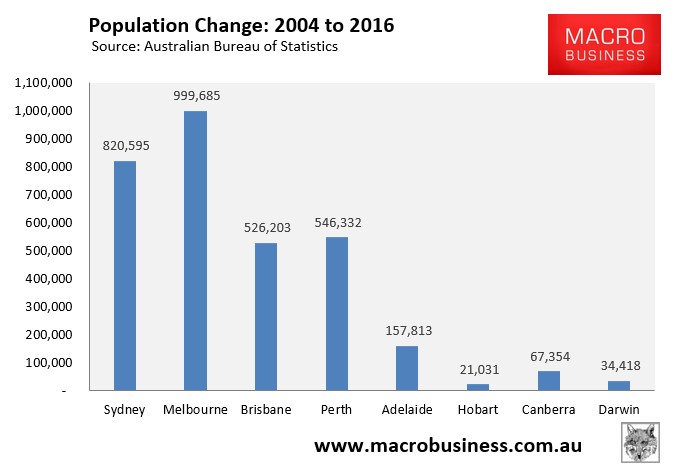
Because of mass immigration, Sydney’s population is projected to grow by 87,000 people per year (1,650 people each week) to 6.4 million over the next 20-years – effectively adding another Perth to the city’s population:
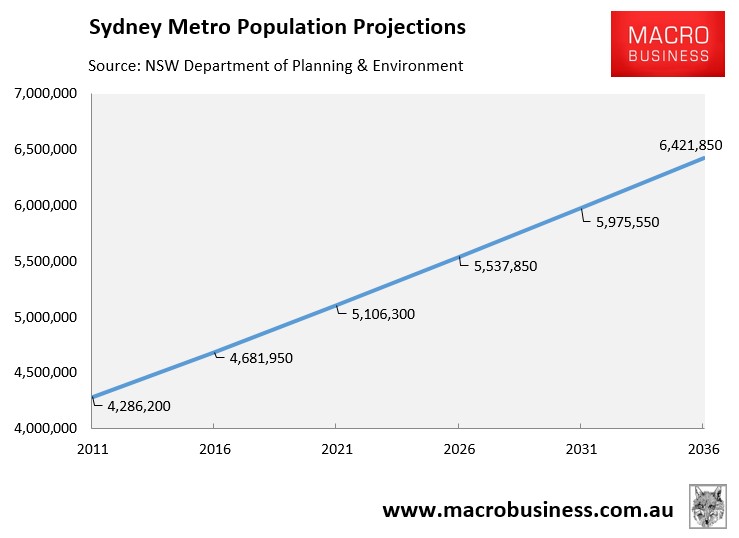
Whereas Melbourne’s population is projected to balloon by 97,000 people per year (1,870 people each week) over the next 35 years to more than 8 million people:
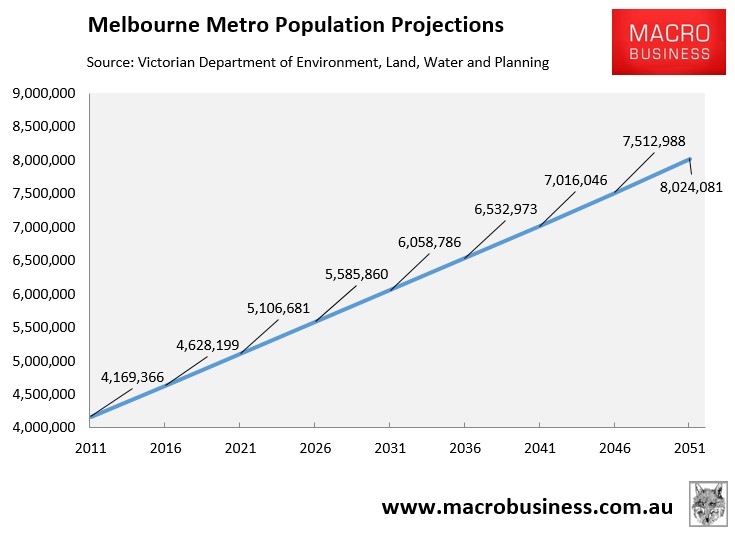
Yet, despite these irrefutable facts, Phil Lowe, the Turnbull Government, and others continue to pin the blame for Sydney’s and Melbourne’s housing crisis on dwelling supply not keeping up with demand – completely ignoring mass immigration’s preeminent role in the matter.
The fact remains that it is a direct policy choice how ‘big’ Australia becomes, not a fait accompli.
As shown in the next chart, which comes from the Productivity Commission, Australia’s population will reach more than 40 million mid-century under current immigration settings, at least 13 million more than would occur under zero net overseas migration (NOM):
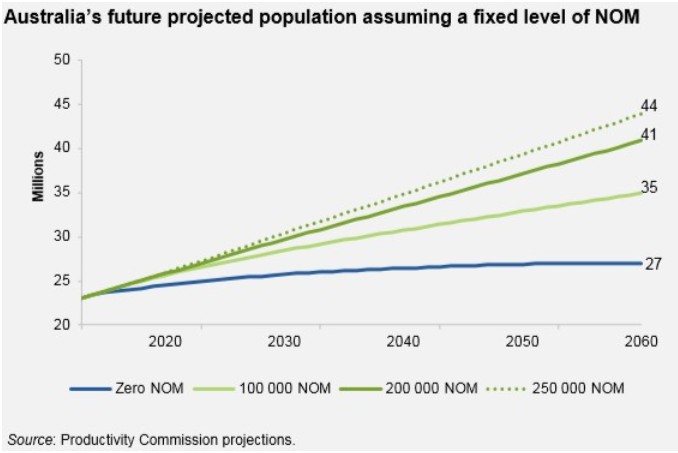
That’s a helluva lot of extra people to build infrastructure and housing for versus a lower or zero NOM policy.
Instead of hand-wringing over Australia’s housing crisis and inadequate infrastructure investment, how about Phil Low, our politicians, policy makers and the media instead question Australia’s mass immigration settings, which are the demand-driver causing the problems in the first place? Why not include as a solution reducing immigration to the long-run norm of 70,000 people a year?

